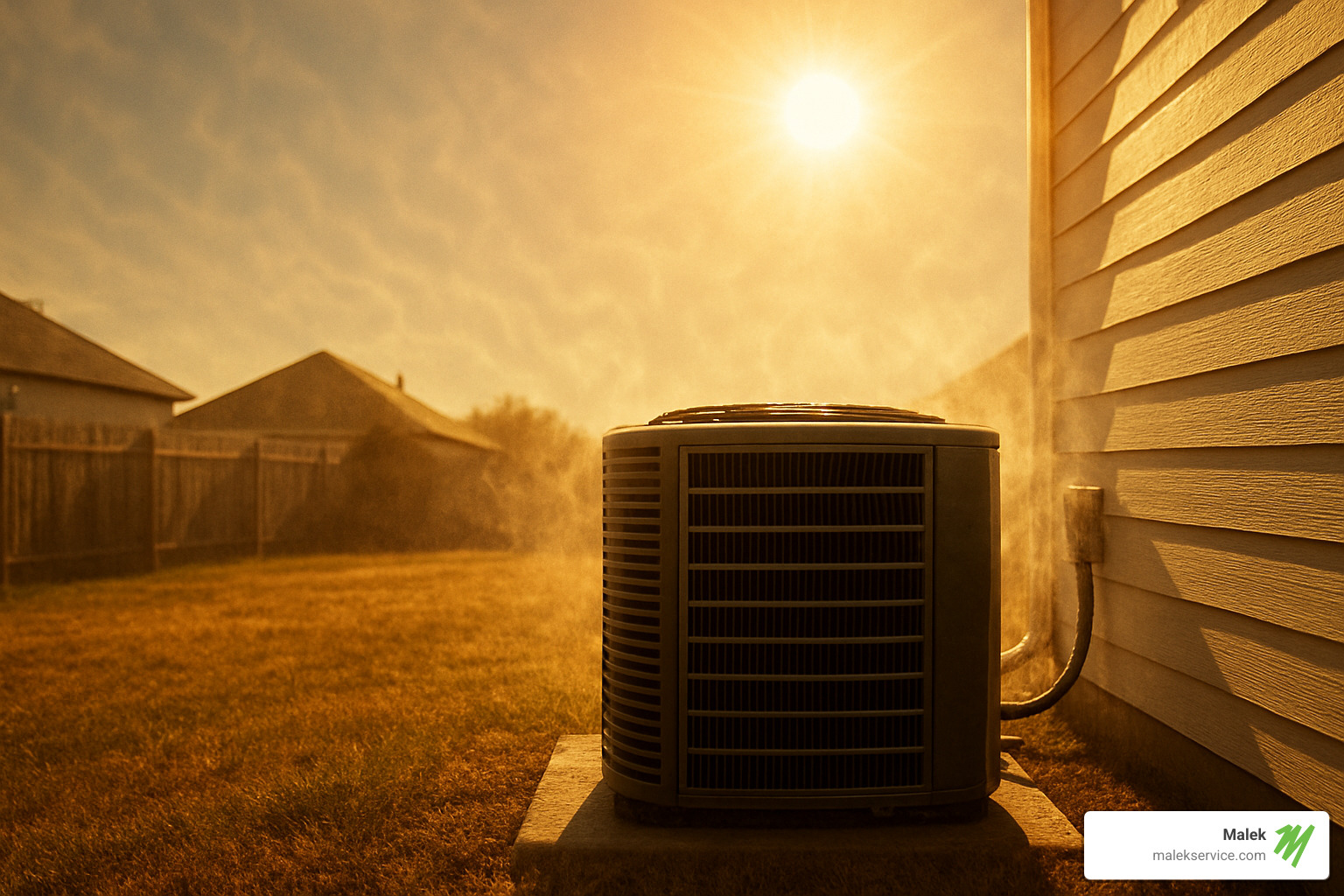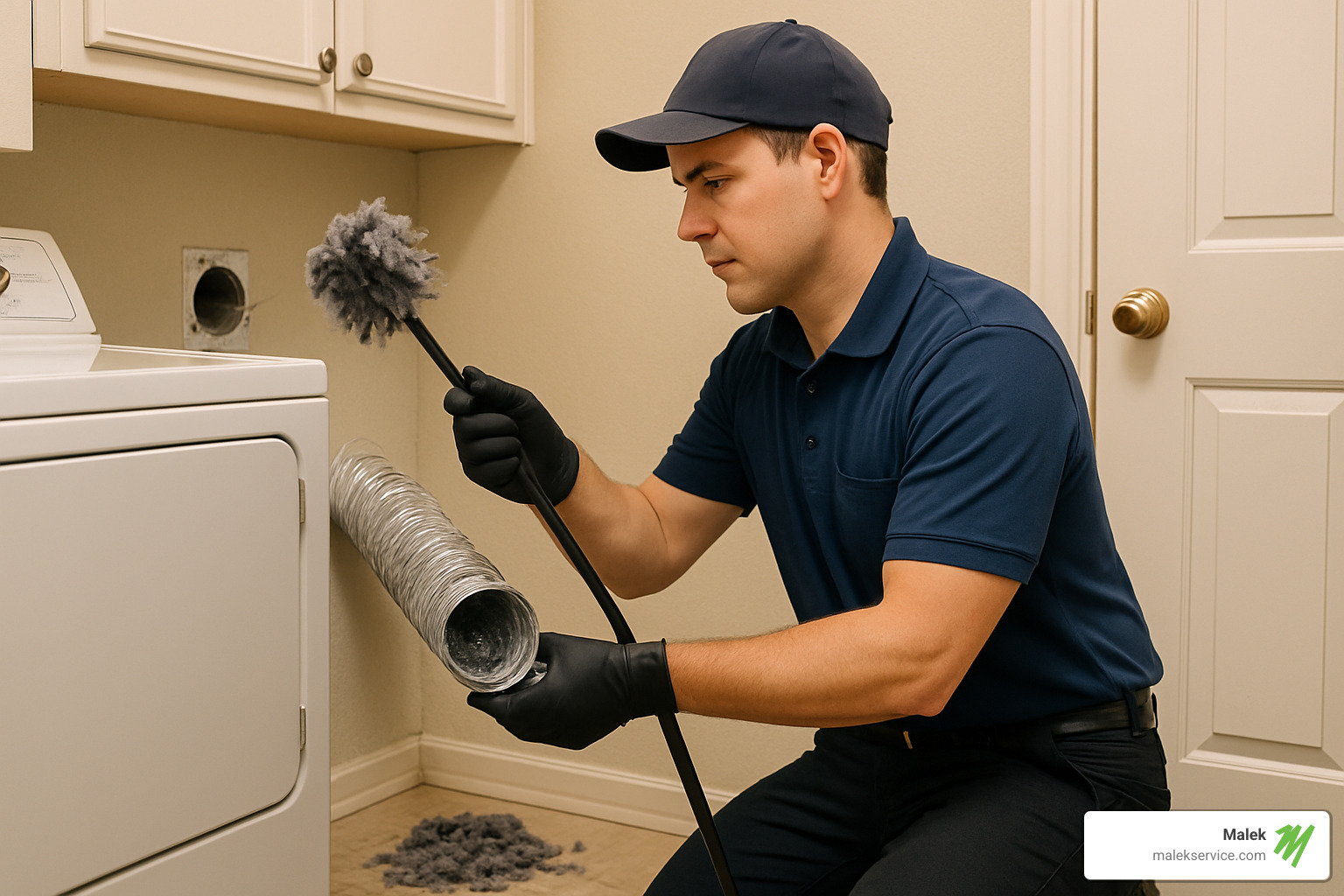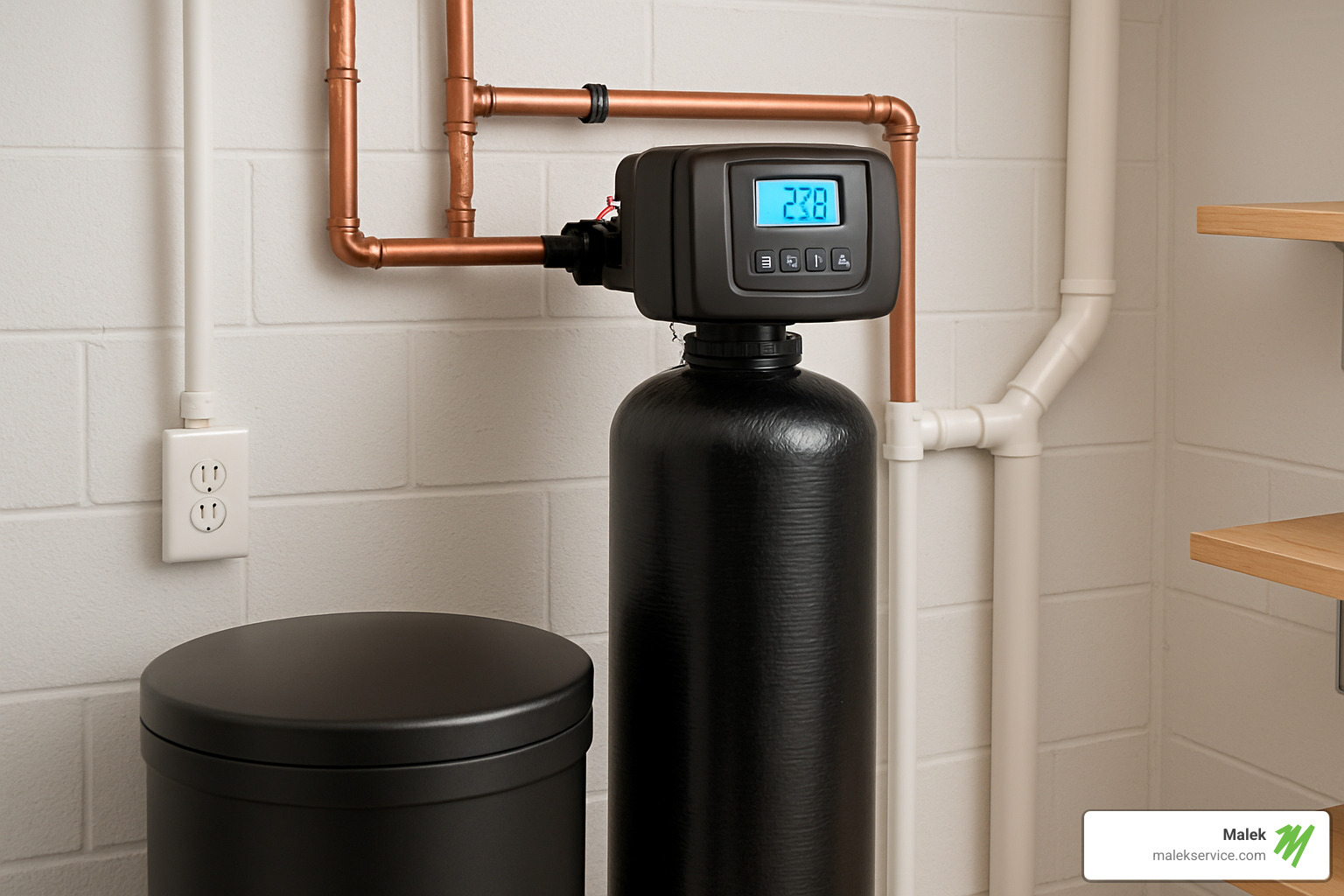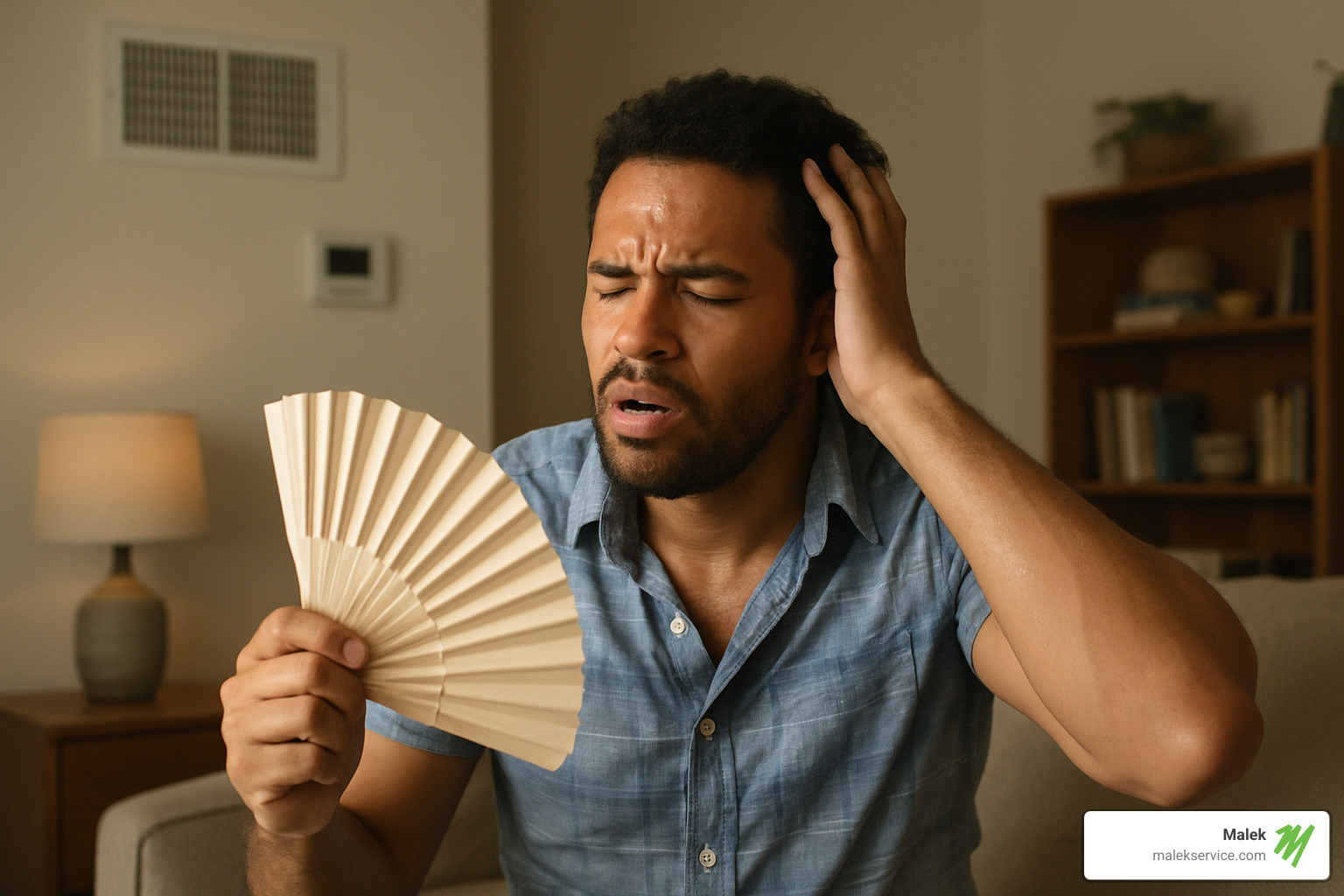Why Your AC Can’t Keep Up During Heat Waves
When your AC can’t keep up with heat, it’s usually due to one of these common reasons:
| Reason | Explanation |
|---|---|
| 20°F Design Limit | Most AC units can only cool about 20°F below outside temperature |
| Undersized System | AC units are designed to work efficiently for 98% of typical temperatures |
| Dirty Air Filters | Restricted airflow prevents proper cooling |
| Leaky Ductwork | Up to 30% of cooled air can escape through duct leaks |
| Poor Insulation | Heat enters faster than your AC can remove it |
It’s a scorching summer day, and despite your thermostat set to 72°F, your home temperature won’t drop below 80°F. This frustrating scenario plays out in millions of homes during heat waves, leaving homeowners wondering what’s wrong with their cooling systems.
The truth is, your air conditioner isn’t necessarily broken. Air conditioning systems have physical limitations that many homeowners don’t realize until extreme heat strikes.
Think of your AC like a marathon runner in the desert – it can only perform so well under extreme conditions. When outdoor temperatures soar above 95°F, even well-maintained systems struggle to maintain comfortable indoor temperatures.
I’m Courtney Zalesak, Vice President at Malek Service Company with over a decade of experience helping Texas homeowners solve problems when their AC can’t keep up with heat. I’ve personally guided hundreds of homeowners through the challenges of maintaining comfortable indoor temperatures during our brutal Texas summers.
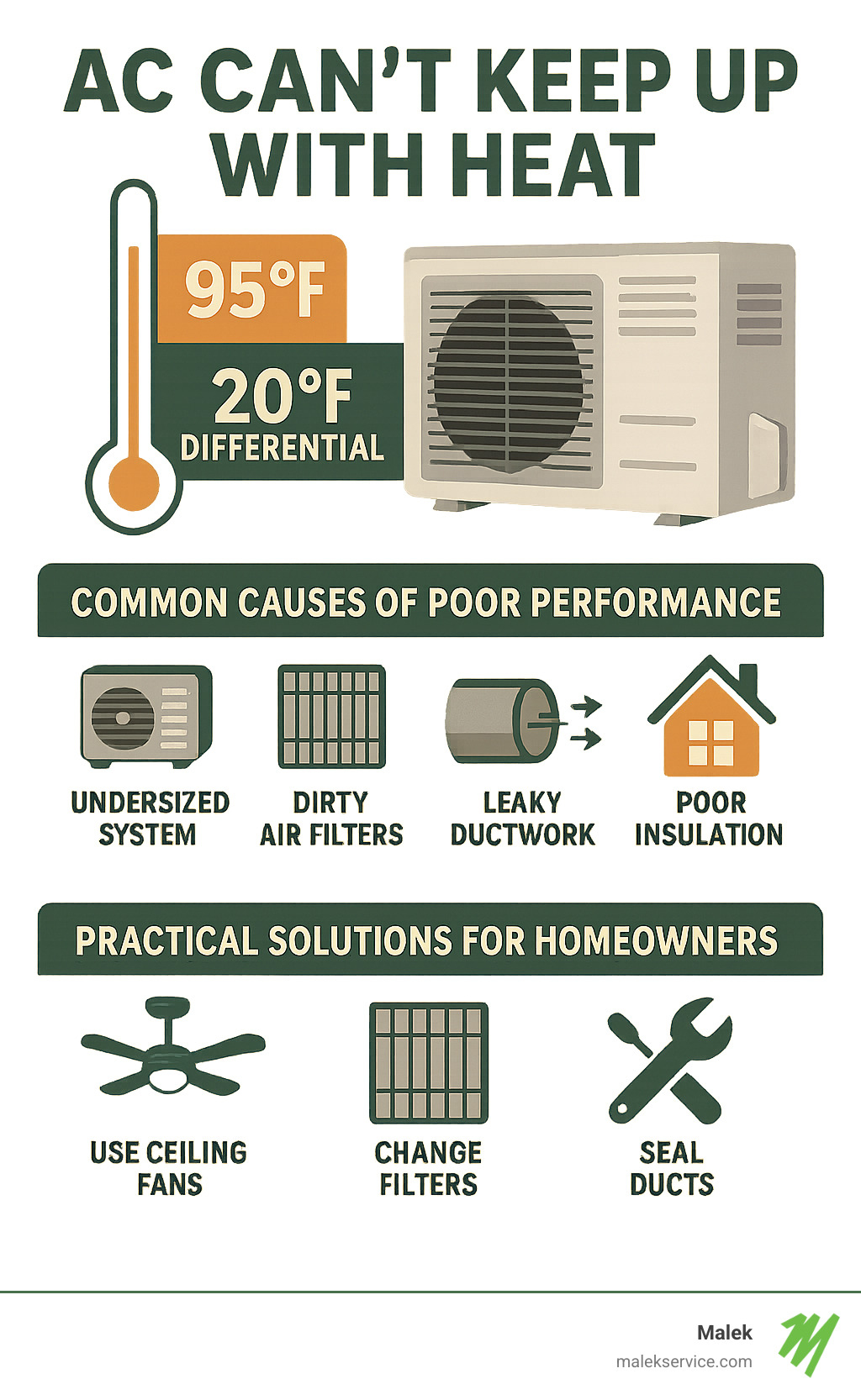
The Science Behind AC Sizing & Limits
Ever wonder why your AC can’t keep up with heat during those scorching summer days? The answer lies in how these systems are designed and the physical limits they operate within.
The 98% Rule: Why Your AC Isn’t Built for Extreme Heat
Here’s something that surprises most homeowners: your air conditioner wasn’t built to handle the absolute hottest days of the year. Strange but true!
Air conditioning systems are intentionally sized to work efficiently for about 98% of typical high temperatures in your area. During that remaining 2% – those brutal heatwaves – your system is actually designed to fall a bit short.
This isn’t a mistake or a way to save money during installation. It’s actually smart engineering that balances comfort with practicality. Think about it: would you buy a winter coat rated for Arctic expeditions just for those few freezing days each year? Probably not!
A system sized for the absolute hottest days would cost significantly more upfront, consume excess energy during normal weather, cycle on and off too frequently (wearing out parts faster), and do a poor job controlling humidity. By sizing for the 98% mark, your system runs more efficiently overall and lasts longer.
The 20°F Differential: Physics Sets the Limit
Your air conditioner faces another challenge – what HVAC pros call the “20°F differential.” In simple terms, your AC typically can only cool your home to about 20 degrees below the outside temperature.
So when it’s 100°F outside and your thermostat is set to 72°F, your system might run continuously but only manage to reach about 80°F inside. This isn’t because something’s broken – it’s basic physics at work.
As the temperature gap between inside and outside grows larger, your AC has to work harder to move each additional degree of heat. It’s like trying to paddle upstream against an increasingly strong current – eventually, you reach a point where you just can’t make more progress no matter how hard you try.
Manual J: The Science of Proper Sizing
Professional HVAC technicians rely on something called a “Manual J load calculation” to determine the right size system for your home. This isn’t a simple square-footage formula – it’s a comprehensive analysis that considers:
Your home’s square footage, ceiling height, window sizes and types, insulation values, which direction your home faces, local climate data, how many people live there, and even heat from appliances all factor into this calculation.
Unfortunately, many homes have improperly sized systems because some installers skip this crucial step or use shortcuts. As one HVAC professional puts it: “When everything is new, it’s likely a design/install problem, not physics. Homeowners should push back harder on HVAC contractors offering excuses.”
The Oversizing Pitfall: Bigger Isn’t Better
When your AC can’t keep up with heat, you might think installing a bigger unit would solve the problem. Surprisingly, oversizing creates more problems than it solves.
An oversized unit will cool your home quickly but then shut off before properly dehumidifying the air. This leads to a clammy feeling and temperature swings as the system frequently cycles on and off. This short cycling increases wear and tear, raises energy bills, and ultimately shortens the lifespan of your expensive equipment.
Lowering your thermostat doesn’t make your AC work faster – it just makes it work longer. Your system cools at the same rate regardless of whether you set it to 72°F or 68°F.
Understanding these fundamental limitations can help you make smarter decisions about your home comfort system and set realistic expectations during extreme weather. At Malek Service, we take the time to perform proper load calculations and explain these concepts so you can make informed choices about your home comfort.
AC can’t keep up with heat: Common Culprits Explained
When your AC can’t keep up with heat, it’s frustrating to say the least. Is your system broken, or is it just the reality of extreme weather? Let’s explore what might be happening when your home feels more like a sauna than the cool retreat you’re paying for.
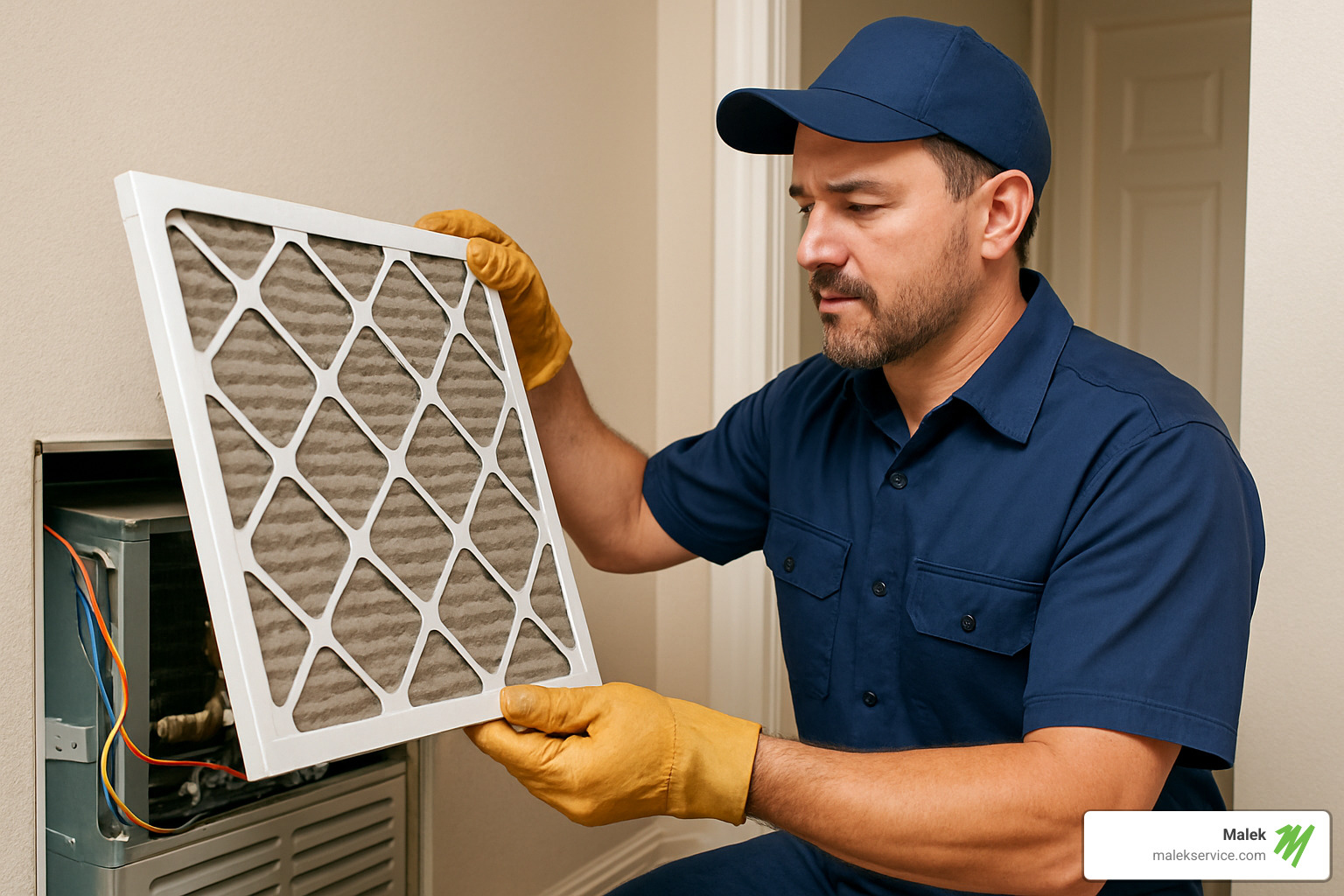
Mechanical Problems: When “AC can’t keep up with heat” Signals Trouble
Sometimes your cooling struggles point to fixable mechanical issues that, once addressed, can restore comfort to your home.
Dirty Air Filters: The #1 Culprit
That thin piece of material might seem insignificant, but a clogged air filter is actually the most common reason your AC can’t keep up with heat. When dust and debris build up, it’s like trying to breathe through a thick blanket – your system gasps for air while working overtime.
Most manufacturers recommend changing filters every 1-3 months, especially during summer when your system runs constantly. You’ll know it’s time when you see visible dust accumulation, feel reduced airflow from vents, or notice your system running longer than usual. Your energy bills might also creep up as your system struggles harder to do its job.
Low Refrigerant Levels: The Cooling Lifeblood
Refrigerant isn’t like gas in your car – it doesn’t get “used up” during normal operation. If your refrigerant is low, you have a leak that needs fixing. Without enough of this cooling fluid, your system might run constantly while barely cooling your home.
Listen for hissing or bubbling sounds near refrigerant lines – these are telltale signs of a leak. You might also notice ice forming on refrigerant lines or the evaporator coil, which ironically happens because low refrigerant causes the system to get too cold in some spots while failing to cool your home.
Dirty Coils: Heat Exchange Barriers
Your AC works by transferring heat, not creating cold air. This heat exchange happens at two crucial coils: the indoor evaporator coil and the outdoor condenser coil. When either gets dirty, it’s like wearing a winter coat in summer – heat can’t transfer efficiently.
The outdoor condenser coil is especially vulnerable since it collects dirt, leaves, grass clippings, and even that fluffy cottonwood seed that floats through the air. A simple cleaning with a brush or coil cleaner can dramatically improve your system’s performance during hot weather.
Leaky Ductwork: The Hidden Efficiency Killer
Imagine paying to cool air that never reaches your living space. That’s exactly what happens with leaky ducts, where up to 30% of your conditioned air escapes into attics, crawl spaces, or inside walls. If some rooms in your home feel perfect while others remain stuffy, duct leaks might be the culprit.
For professional diagnosis and repair of these mechanical issues, our College Station AC Repair team can quickly identify and fix what’s wrong, often in a single visit.
Design or Environment: When “AC can’t keep up with heat” Is Totally Normal
Sometimes your AC can’t keep up with heat simply because external factors are overwhelming even a perfectly functioning system. In these cases, understanding the limitations helps set realistic expectations.
Record-Breaking Heat Waves
Your AC system was designed based on historical temperature patterns in your region. When we experience those “hottest day on record” heat waves that seem increasingly common, your system may struggle simply because it wasn’t engineered for these extremes. It’s like asking a car designed for highway driving to suddenly perform in an off-road rally – it might manage, but not optimally.
During these extreme weather events, adjusting your expectations and using supplemental cooling strategies becomes important for maintaining comfort.
Poor Home Insulation and Air Sealing
Even the most powerful AC system can’t keep up if your home’s “envelope” is leaky. Inadequate attic insulation, air gaps around windows and doors, uninsulated walls, and aging windows all allow precious cool air to escape while hot air infiltrates.
Think of it like trying to cool a cooler with the lid partially open – you’re fighting a losing battle. Improving your home’s insulation and sealing can often do more for comfort than upgrading your AC system.
Solar Heat Gain Through Windows
Those beautiful south and west-facing windows that bring in natural light are also letting in tremendous heat during summer afternoons. This greenhouse effect can add thousands of BTUs of heat that your AC must remove.
External shade screens, window films, or even strategically placed trees can block this heat before it enters your home, giving your AC system a fighting chance during the hottest parts of the day.
Attic Temperatures and Duct Location
Ever been in an attic on a summer day? Temperatures can soar to 150°F – hot enough to slow-cook dinner! If your ductwork runs through this space, the cool air inside absorbs heat before reaching your rooms. Similarly, air handlers located in hot attics operate less efficiently.
Improving attic ventilation, adding radiant barriers, or insulating ductwork can help your system deliver more of its cooling capacity where you need it.
According to scientific research on ideal thermostat settings, setting your thermostat to 78°F during summer provides the best balance of comfort and efficiency. Each degree cooler increases your energy consumption by 3-5%, while potentially overtaxing your system during extreme heat.
DIY Maintenance & Home Hacks to Help Your AC
When your AC can’t keep up with heat, there are several steps you can take yourself before calling in the professionals. These DIY approaches can significantly improve your AC’s performance during heat waves.
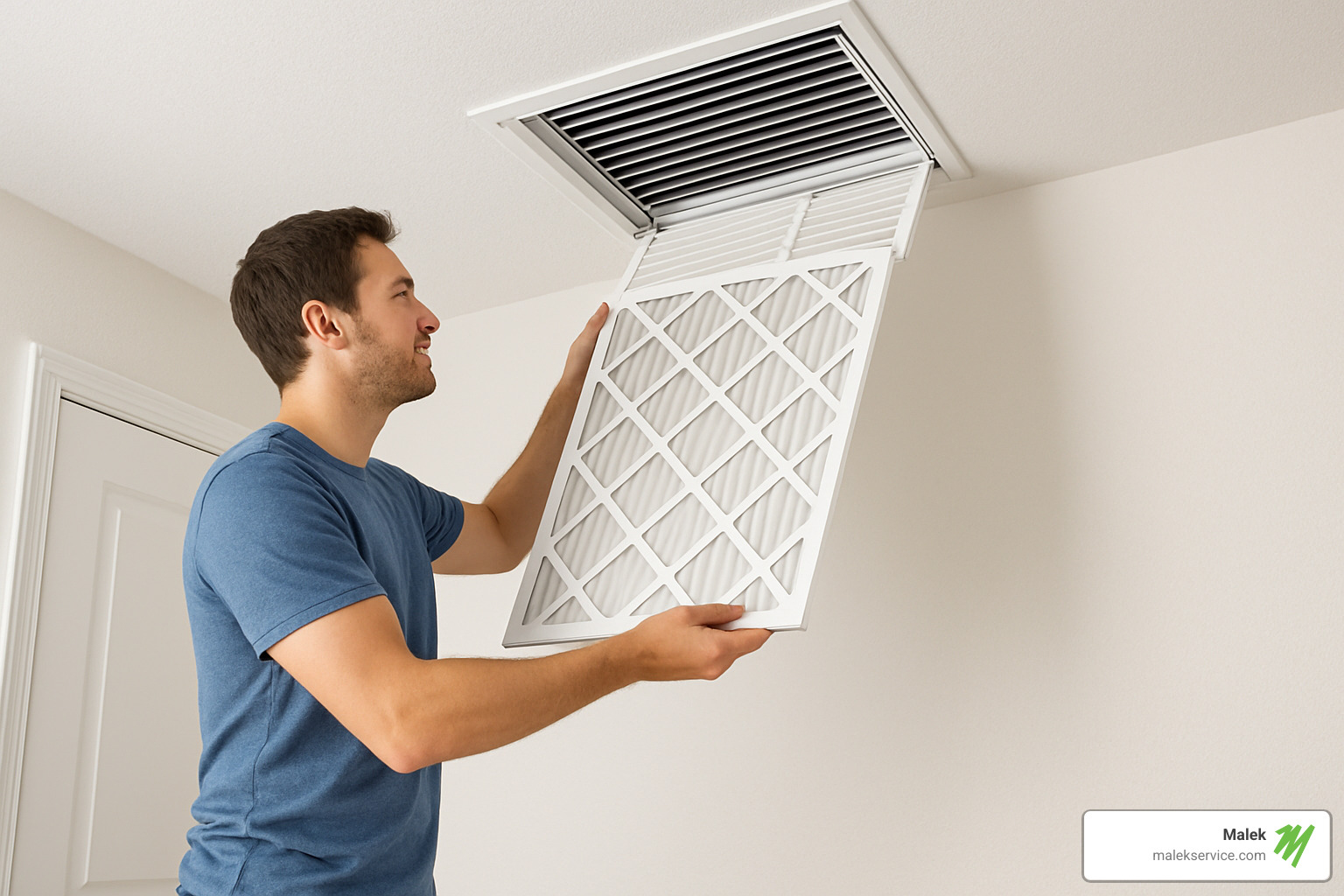
Top 5 Five-Minute Fixes
Let’s be honest – when temperatures soar, you want solutions that work right now. Here are five quick fixes that can make an immediate difference:
Replace those air filters regularly, ideally every 1-3 months. I can’t stress this enough – clean filters are absolutely critical for proper airflow. This simple 30-second swap can boost your system’s efficiency by 5-15%. It’s like letting your AC take a deep breath after wearing a mask for too long.
Clear the space around your outdoor unit. Your condenser needs to breathe! Keep at least 1-2 feet of clearance by removing leaves, grass clippings, and enthusiastic vegetation that might be crowding it. Your AC will thank you with better performance.
Be strategic with your blinds and curtains during peak sun hours. Think of your windows as tiny greenhouses – east-facing blinds should be closed in the morning, west-facing ones in the afternoon. One energy expert I know calls this “playing defense against the sun,” and it can reduce heat gain by up to 30%.
Put those ceiling fans to work in occupied rooms. While fans don’t actually lower temperature, they create a pleasant wind-chill effect that can make a room feel 4°F cooler. Just remember to turn them off when you leave – fans cool people, not rooms!
Adjust your thermostat expectations during extreme heat. Setting your thermostat to 78°F when home and 82-85°F when away can dramatically reduce strain on your system. Each degree closer to the outside temperature gives your AC a little breathing room.
Beyond the Basics: More DIY Approaches
Keep cooking outdoors whenever possible during heat waves. Your kitchen appliances are secretly working against your AC! “Cooking indoors can raise your indoor temperature by up to 10°F,” according to home energy experts. Fire up the grill, accept no-cook meals, or use smaller appliances that generate less heat.
Seal those sneaky air leaks around doors and windows. Weather-stripping is an inexpensive weekend project that pays big dividends. Those tiny gaps are like leaving a window cracked open all day – they let precious cool air escape while inviting heat inside. A proper seal can improve cooling efficiency by 10-15%.
Make your thermostat work smarter, not harder. If you have a programmable or smart thermostat, use it strategically. Pre-cool your home before peak heat hours, allow slightly higher temperatures during the hottest part of the day, and create a schedule that matches when you’re actually home. Your system will run more efficiently, and your wallet will notice the difference.
Give your condenser coil a gentle bath. Over time, your outdoor unit collects dirt that acts like a blanket, trapping heat. With the power turned off at the breaker, you can carefully remove large debris and gently spray water from inside out through the coil. Just remember – this is a gentle rinse, not a pressure washing! Those delicate fins bend easily.
For those wanting more comprehensive maintenance, our AC Tune-Up service provides professional cleaning and inspection to ensure your system is operating at peak efficiency. Think of it as a spa day for your AC – it comes back refreshed and ready to perform.
These DIY steps can make a significant difference when your AC can’t keep up with heat, but they’re not magic. During extreme heat waves, even well-maintained systems have their limits. These steps will help your system perform its best during challenging conditions while potentially saving you from an unnecessary service call.
Pro Diagnostics, Upgrades & Smart Improvements
When DIY approaches aren’t enough and your AC can’t keep up with heat, professional diagnostics and strategic upgrades may be necessary.
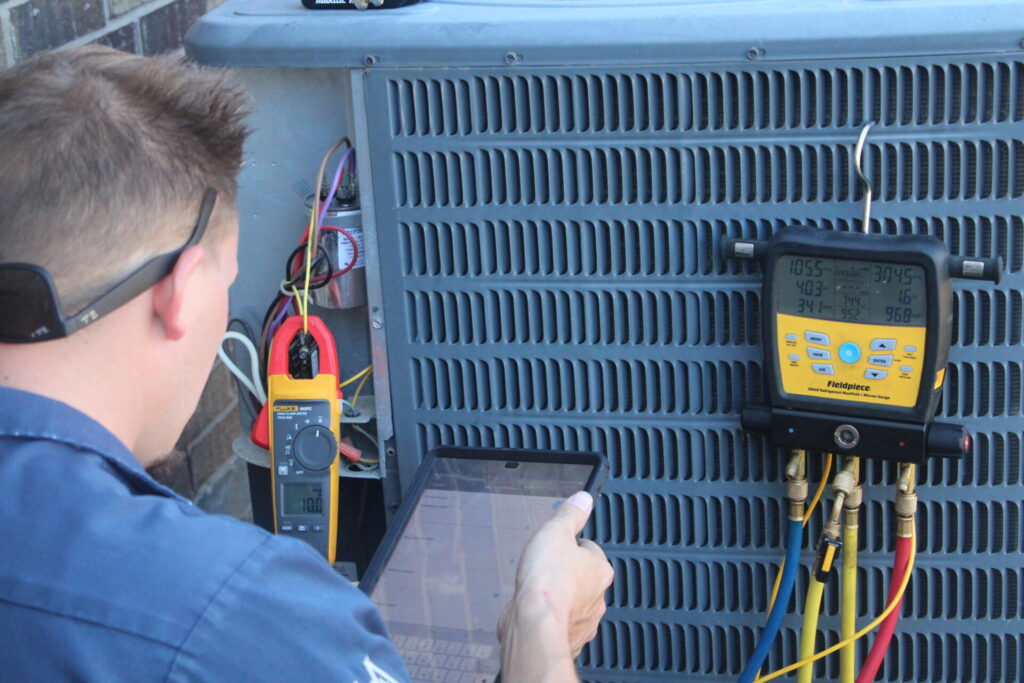
Professional Diagnostics: Finding Hidden Issues
When your home feels like an oven despite your best efforts, it might be time to call in the pros. Our Malek Service technicians bring specialized tools and expertise that can uncover problems invisible to the untrained eye.
Think of it like going to the doctor when home remedies aren’t working. We don’t just guess—we measure. Using refrigerant pressure testing, we can detect even tiny leaks that might be robbing your system of its cooling power. Our specialized anemometers measure the actual airflow coming from each vent, telling us if your system is distributing air properly throughout your home.
One of our customers’ favorite diagnostic tools is our thermal imaging camera. This almost feels like magic—we can literally see heat passing through your walls and pinpoint exactly where your insulation is failing or where duct leaks are hiding.
“Using a temperature gun and an anemometer to measure what’s happening at the vents” isn’t just technical jargon—it’s how we transform guesswork into certainty, saving you time and money by fixing what’s actually broken.
Strategic Upgrades: When Replacement Makes Sense
Sometimes the smartest financial decision isn’t patching up an aging system. It’s like deciding whether to repair an old car—at some point, the math simply favors starting fresh.
| Issue | Repair Cost | Replacement Cost | 10-Year Operating Savings | Better Choice |
|---|---|---|---|---|
| 15+ year old unit | $500-1,500 | $4,000-8,000 | $3,000-5,000 | Replacement |
| Refrigerant leak | $200-1,500 | $4,000-8,000 | $1,500-3,000 | Depends on age |
| Compressor failure | $1,500-2,500 | $4,000-8,000 | $2,000-4,000 | Replacement if 10+ years old |
| Dirty coils/filter | $150-500 | $4,000-8,000 | Minimal | Repair |
| Undersized unit | N/A | $4,000-8,000 | $1,000-2,000 | Replacement |
I’ve seen the relief on homeowners’ faces when they finally replace a 15-year-old system that’s been limping along. Yes, the upfront cost feels significant, but the comfort difference is immediate, and the energy savings start accumulating from day one. When your AC can’t keep up with heat because it’s simply past its prime, replacement often brings both comfort and financial peace of mind.
High-Impact Home Improvements
Your air conditioner doesn’t work in isolation—it’s fighting against all the heat trying to enter your home. Here’s how we can help your AC win that battle:
Professional Duct Sealing
Did you know you might be cooling your attic instead of your living room? “Air duct leaks can cause you to lose about a third of your HVAC system’s efficiency,” according to energy efficiency studies. That’s like driving with a third of your gas tank deliberately leaking onto the road!
Professional duct sealing isn’t the same as slapping on some duct tape (which, ironically, isn’t actually good for ducts). We use specialized aerosol-based technologies or mastic sealant that can reach leaks in places you can’t even access. The results? Rooms that finally cool evenly, lower energy bills, and an AC system that can finally catch its breath.
Attic Insulation and Ventilation
Your attic is like a heat collector sitting right on top of your living space. “Attic temperatures can reach as high as 150°F in summer without proper ventilation,” notes one building science expert. That’s hot enough to bake cookies! This massive heat reservoir constantly pushes warmth into your home.
Adding proper insulation (we recommend R-49 for most Texas climates) creates a thermal barrier that dramatically reduces this heat transfer. Combined with improved ventilation through ridge vents, soffit vents, or properly installed powered ventilators, your attic stops being your AC’s worst enemy.
The difference is remarkable—many homeowners report their second-floor bedrooms finally becoming comfortable after years of sweaty summer nights.
High-SEER AC Upgrades
Today’s air conditioners are to old units what smartphones are to rotary phones—a complete technology upgrade. According to scientific research on SEER ratings, jumping from an older 10 SEER unit to a modern 16+ SEER system can slash cooling costs by 30-50%.
Modern high-efficiency units don’t just use less electricity—they cool differently. Variable-speed compressors adjust their output to match conditions instead of just blasting at full power then shutting off. This means more consistent temperatures, better humidity control, and whisper-quiet operation. They’re also smart enough to tell you when something’s wrong before small problems become expensive repairs.
Zoning Systems
Why cool empty rooms? Zoning systems are like having multiple thermostats that control different areas of your home independently. The guest room stays warmer while you’re not hosting visitors. The kitchen can be cooler while you’re cooking. Your bedroom can be perfect for sleeping without freezing out the rest of the house.
This customized approach not only improves comfort but also reduces the workload on your system when your AC can’t keep up with heat throughout the entire house.
Our comprehensive AC Maintenance Services include personalized evaluations to help identify which improvements make the most sense for your home and budget. We won’t recommend replacing what can be fixed, and we won’t waste your money patching what should be replaced. That’s the Malek difference—honest advice from people who care about your comfort.
Frequently Asked Questions about AC Performance in Extreme Heat
Why can’t my air conditioner hit the set temperature during a heatwave?
When your AC can’t keep up with heat during those sweltering summer days, it’s easy to worry something’s seriously wrong. The truth is, there are several perfectly normal explanations for this common frustration.
First, your AC system has physical limitations built into its design. Most residential units can only cool about 20°F below whatever the outdoor temperature is. So during those 100°F scorchers, your system might be working perfectly even if it can only maintain 80°F indoors. That’s not a malfunction—it’s physics at work!
Your AC was also sized based on historical weather patterns in your area. Engineers design systems to handle about 98% of expected temperature conditions, not the extreme outliers. During that hottest 2% of summer days, your system may struggle simply because it was designed that way for overall efficiency.
The way your home gains heat matters too. Think of your house like a cooler—if the lid keeps opening or the insulation is thin, ice melts faster than it should. Similarly, if heat enters your home faster than your AC can remove it through poor insulation, leaky windows, or unsealed doors, indoor temperatures will inevitably rise.
System inefficiencies can compound these challenges. Dirty filters, grimy coils, or low refrigerant levels all reduce your system’s cooling capacity—issues that become glaringly obvious during extreme heat but might go unnoticed in milder weather.
As one of our technicians likes to say: “If your AC’s struggling like a marathon runner in a desert, don’t worry—solutions are at hand.” Sometimes understanding the normal limitations helps ease the frustration while you work on improvements.
Is buying a bigger unit really the best fix if my AC can’t keep up with heat?
It’s a common misconception that when your AC can’t keep up with heat, you just need a bigger, more powerful unit. This “bigger is better” approach actually creates more problems than it solves.
Oversized air conditioners cool your space too quickly, then shut off before completing a full cycle. This “short cycling” causes uncomfortable temperature swings throughout your home. One minute you’re chilly, the next you’re warm again. Even worse, these shorter cycles don’t run long enough to properly dehumidify your air, leaving your home feeling clammy and uncomfortable.
Your wallet takes a hit in multiple ways too. The startup phase of any AC cycle consumes the most energy, so a system that frequently starts and stops drives up utility bills significantly. Those same frequent cycles put extra wear and tear on critical components, shortening your system’s lifespan and leading to premature replacement costs. And of course, larger units come with higher upfront purchase and installation costs.
“Oversized units short-cycle, remove humidity poorly, wear out faster, and drive up utility bills,” as our senior technician often reminds homeowners who ask about upsizing.
Instead of going bigger, consider these smarter alternatives: improving your home’s insulation and sealing air leaks; installing zoning systems that direct cooling where it’s needed most; adding a supplemental mini-split in perpetually warm rooms; or upgrading to a properly-sized system with a higher SEER rating for better efficiency.
These approaches address the root causes of cooling problems rather than masking symptoms with brute cooling force that ultimately creates new issues.
How do I know if low refrigerant is why my AC can’t keep up with heat?
Refrigerant issues are common culprits when your AC can’t keep up with heat, but they can be tricky to diagnose without professional equipment. There are, however, some telltale signs you can watch for.
If your system runs continuously but provides little cooling effect, refrigerant levels might be low. You might notice ice forming on refrigerant lines or the evaporator coil—ironically, low refrigerant often causes freezing because the remaining refrigerant expands too much, creating super-cooled conditions that freeze condensation on the coils.
Listen carefully near your indoor unit or refrigerant lines. Hissing or bubbling sounds could indicate a refrigerant leak, especially if they come and go as the system cycles. Your cooling cycles might also become noticeably longer than usual as the system struggles to reach your desired temperature.
Check your electric bills too. A system low on refrigerant works much harder than normal, consuming significantly more electricity while delivering less cooling.
It’s important to understand that, unlike fuel in a car, refrigerant doesn’t get “used up” during normal operation. It circulates in a closed loop, so if levels are low, it means there’s a leak somewhere that needs professional repair.
“Listening for hissing or bubbling sounds as a DIY refrigerant leak indicator” can help homeowners spot potential problems, but accurate diagnosis requires professional testing with specialized gauges and equipment.
Refrigerant handling is strictly regulated by federal law due to environmental concerns. Only EPA-certified technicians should check or recharge your system. Our technicians at Malek Service have the proper certification, equipment, and experience to safely diagnose and resolve refrigerant issues, helping your AC perform at its best even during challenging heat waves.
Conclusion
When your AC can’t keep up with heat, it’s easy to feel frustrated and helpless. Trust me, I’ve been there too! Understanding why your home feels like an oven despite your AC running full-blast is the first step toward finding real solutions.
We’ve covered a lot of ground in this article, from the science of cooling to practical fixes you can tackle yourself. The truth is, air conditioners have physical limitations that become most apparent during those brutal summer heat waves we experience here in Texas.
Remember these simple truths about cooling your home:
Your AC is designed to cool about 20°F below the outside temperature – not more. When it’s 100°F outside, expecting your home to be 70°F inside is asking your system to defy physics!
There’s actually a good reason your system was sized to handle only 98% of typical weather conditions. It’s a deliberate choice that balances efficiency, cost, and performance for the majority of the year.
I can’t stress enough how important regular maintenance is. Something as simple as changing your filter monthly during summer can dramatically improve your comfort and prevent costly repairs down the road.
Small changes around your home – closing blinds during the day, cooking outdoors, using ceiling fans – can make a surprising difference in how effectively your AC works. These little habits add up to significant comfort improvements.
Sometimes, despite your best DIY efforts, you need a professional’s help. Whether it’s diagnosing a refrigerant leak or determining if your system is properly sized, experienced technicians have the tools and knowledge to solve problems you simply can’t tackle alone.
Here at Malek Service, we understand the unique challenges Texas homeowners face during our sweltering summers. Our technicians live and work in the same communities you do – we’re experiencing those same heat waves! That’s why we continuously train on the latest cooling technologies and approaches.
Whether you need a simple tune-up to maximize your current system’s performance or you’re considering upgrading to a more efficient model, our Air Conditioning Repair & Installation team is ready to help with honest advice and quality service.
Don’t let the heat win this summer. With the right approach and a little expert guidance, you can maintain a comfortable home even during the most challenging Texas heat waves. Your comfort is our priority, and we’re just one call away when you need us.
